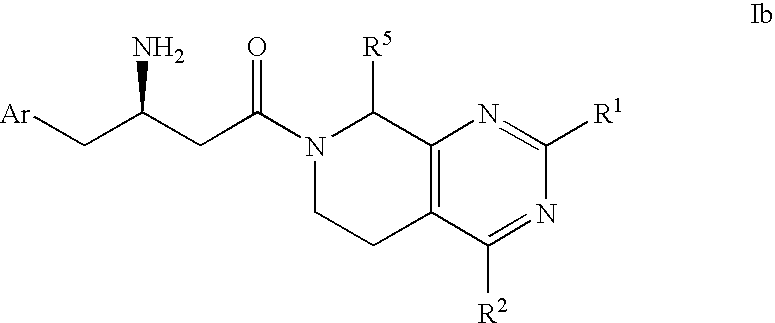Piperidino pyrimidine dipeptidyl peptidase inhibitors for the treatment of diabetes
a technology of pyrimidine dipeptidyl peptidase and insulin, which is applied in the direction of biocide, drug composition, metabolic disorder, etc., can solve the problems of increased and premature morbidity and mortality, increased risk of macrovascular and microvascular complications in patients with type 2 diabetes mellitus, and increased risk of macrovascular and microvascular complications in patients
- Summary
- Abstract
- Description
- Claims
- Application Information
AI Technical Summary
Benefits of technology
Problems solved by technology
Method used
Image
Examples
example 1
[0258]
7-[(3R)-3-Amino-4-(2,5-difluorophenyl)butanoyl]-2-(trifluoromethyl)-5,6,7,8-tetrahydropyrido[3,4-d]pyrimidin-4-ol
Step A. 7-(Phenylmethyl)-2-(trifluoromethyl)-5,6,7,8-tetrahydropyrido[3,4-d]pyrimidin-4-ol
[0259]To a solution of sodium ethoxide, prepared from 3.2 g (133 mmol) of sodium metal and 200 mL of absolute ethanol, at ambient temperature was added 8.3 g (74 mmol) of trifluoroacetamidine followed by 17.8 g (60 mmol) of ethyl 1-benzyl-3-oxopiperidinecarboxylate hydrochloride in portions over 15 min. The reaction mixture was stirred at ambient temperature for 1 h, then heated at reflux for 30 h. The mixture was concentrated in vacuo. The resultant red foam was partitioned between 300 mL of 1 N aqueous sodium hydroxide solution and 300 mL of ether. The aqueous layer was washed with 300 mL of ether and the combined ether phases were extracted with 50 mL of 1 N aqueous sodium hydroxide solution. The combined aqueous phases were cooled in an ice-water bath and neutralized to pH ...
example 2
[0262]
7-[(3R)-3-Amino-4-(2,4,5-trifluorophenyl)butanoyl]-2-(trifluoromethyl)-5,6,7,8-tetrahydropyrido[3,4-d]pyrimidine, dihydrochloride
Step A. 4-Chloro-7-(phenylmethyl)-2-(trifluoromethyl)-5,6,7,8-tetrahydropyrido[3,4-d]pyrimidine
[0263]A mixture of 29.6-g (95.7 mmol) of 7-(phenylmethyl)-2-(trifluoromethyl)-5,6,7,8-tetrahydropyrido[3,4-d]pyrimidin-4-ol (prepared essentially as described in Example 1, Step A) and 53 mL of phenylphosphonic dichloride in a 250-mL round bottom flask was heated at 150° C. After 2 h, the reaction was judged to be complete by TLC analysis. The mixture was cooled to ambient temperature and poured onto 400 g of ice, transferring with ˜500 mL of ethyl acetate. The aqueous layer was neutralized with solid sodium bicarbonate and the layers separated. The aqueous layer was extracted with two portions of ethyl acetate. The combined organics were washed sequentially with saturated aqueous sodium bicarbonate solution and brine, dried over sodium sulfate and concentr...
example 3
[0267]
7-[(3R)-3-Amino-4-(2,5-difluorophenyl)butanoyl]-4-methoxy-2-(trifluoromethyl)-5,6,7,8-tetrahydropyrido[3,4-d]pyrimidine, dihydrochloride
Step A. 4-Methoxy-7-(phenylmethyl)-2-(trifluoromethyl)-5,6,7,8-tetrahydropyrido[3,4-d]pyrimidine
[0268]4-Chloro-7-(phenylmethyl)-2-(trifluoromethyl)-5,6,7,8-tetrahydropyrido[3,4-d]pyrimidine (98 mg, 0.30 mmol) and 1.5 mL of 0.5 M sodium methoxide in methanol was warmed to 60° C. overnight. The mixture was concentrated under nitrogen and partitioned between ether and water. The ether layer was washed with brine, dried and concentrated to give 94 mg of the title compound as a yellow oil. LC-MS 324.0 (M+1).
Step B. 4-Methoxy-2-(trifluoromethyl)-5,6,7,8-tetrahydropyrido[3,4-d]pyrimidine, hydrochloride
[0269]A solution of 94 mg (0.30 mmol) of the anine from Step A in 1.5 mL of dichloromethane was treated with 0.041 mL (0.375 mmol) of 1-chloroethyl chloroformate. The solution was warmed to 45° C. for 18 h, cooled to room temperature, and concentrated u...
PUM
| Property | Measurement | Unit |
|---|---|---|
| volume | aaaaa | aaaaa |
| emission wavelength | aaaaa | aaaaa |
| excitation wavelength | aaaaa | aaaaa |
Abstract
Description
Claims
Application Information
 Login to View More
Login to View More - R&D
- Intellectual Property
- Life Sciences
- Materials
- Tech Scout
- Unparalleled Data Quality
- Higher Quality Content
- 60% Fewer Hallucinations
Browse by: Latest US Patents, China's latest patents, Technical Efficacy Thesaurus, Application Domain, Technology Topic, Popular Technical Reports.
© 2025 PatSnap. All rights reserved.Legal|Privacy policy|Modern Slavery Act Transparency Statement|Sitemap|About US| Contact US: help@patsnap.com



